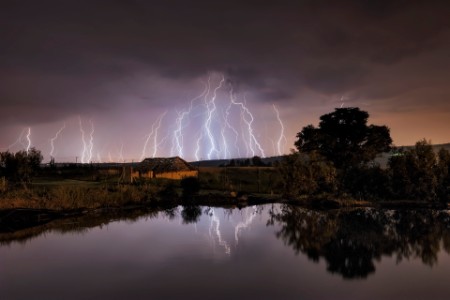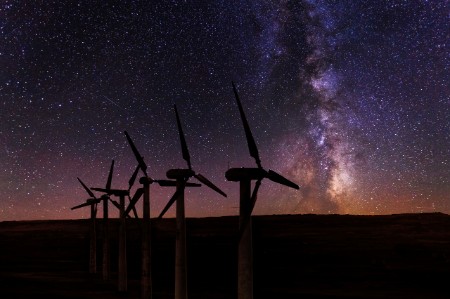
Chapter 1
Four unstoppable forces in the marketplace
Unstoppable market forces will reshape energy no matter what anyone does today.
Consider the following four factors.
1. Economic growth
The world’s population and economy continue to grow. Growth in the developing world has slowed from what we thought it might be, but most of the increase in economic activity in the next 50 years will be in places where the middle-class lifestyle, and the energy use that goes with it, is a brand-new thing. Energy demand will rise at a fairly steady, predictable rate. There isn’t a lot of difference between the most aggressive forecasts and the more conservative ones.
2. Efficiency
Energy demand will rise at a rate lower than economic growth. The developed world hit an inflection point after the initial surge of new energy-using products when we started to pay attention to how much it cost to run them and the engineers focused on efficiency; vehicles went more miles on a gallon of gasoline, and air conditioners and refrigerators improved.
As digitization is the next big thing, vehicles, houses and businesses will get smarter, “driving” themselves in a way that uses the least energy and turning themselves off or powering down when it makes sense. The technology will spill over into the developing world and could completely, or at least partially, offset the wave of new energy users.
3. Electrification
Electricity has always been and will be the vehicle for broader energy use, more energy use and different energy use. Once there is power in a house or a business, the possibilities are endless. The biggest question today is around transportation. When will battery companies make a battery that’s light enough and charges fast enough to compete with gasoline?
4. Decarbonization
Where will more electricity come from? A growing role for coal or nuclear would be a contrarian view at this point. Advances in natural gas might price coal out of the market without regard to environmental issues. In addition, the risk of new carbon regulation, notwithstanding the current political climate in the US, makes long-term investments in coal plants very questionable.
Nuclear power is a carbon-free alternative, but cost and waste disposal need to be resolved. Until that happens, private capital will be scarce. If more nuclear energy is produced, it will be because of geopolitical considerations and government subsidies and guarantees. The most obvious carbon-free path is renewable power, mainly solar and wind, which has grown at a phenomenal rate in the last 10 years (50% and 22% respectively). However, those remain just a little more than 2% of the overall mix, and questions remain about cost and scalability.

Chapter 2
The drivers: three groups shaping the future
We’ve laid out the environment that will define the new energy future.
Economic growth will always push the demand for energy higher, particularly when the economic growth is concentrated in parts of the world that are just learning how energy can enable a higher standard of living. Energy efficiency will continuously improve and pull against economic growth.
Energy is a scarce, costly resource, and people and business will always look to get more from less. Electrification will continue to be the vehicle for broadening and widening the use of energy. When people get access to electricity, the opportunities to use energy, including for transportation, are limitless. Decarbonization is the overarching latest trend, a recognition that sustainability matters.
As we examine the drivers, it becomes clear the decision makers will propel the energy mix from where it is to where it will be. The decision makers fall into three categories: the government and public sector, industry and technology and consumer behavior.
We’ve summarized the spectrum of forecast viewpoints. Suffice to say there is no consensus. No surprise, given the number of unknowns and lack of a reliable methodology to forecast the adoption of new technologies that do essentially the same thing as the old technologies at what might be higher cost and less convenience.
How the future energy mix might look
We’ve summarized and analyzed industry forecasts to create three scenarios:
Hydrocarbon heavy: In this scenario, the energy world of tomorrow doesn’t look a whole lot different from the world of today. None of the technological enablers of renewables materialize, the efficiency of oil and gas extraction continues to improve and consumer and government attitudes don’t force the issue. The energy mix reflects some natural progression toward lower-carbon energy based on current trends and embedded regional commitments to renewables, but oil and gas remain dominant.
Electric evolution: This scenario could be characterized as forced energy diversity. Renewable and electric vehicle technology progresses to a point where they’re competitive at the margin, government support grows somewhat and consumer attitudes support growing market share. Fossil fuels remain competitive and demand for oil grows in response to natural growth in population and the economy, but market share shrinks.
Renewable revolution: In this scenario, transformation moves to at least half renewables to traditional fossil fuels. All of the variables move forward in the same direction, and almost all marginal energy use is sourced from renewables through the electricity grid. New vehicles are mostly electric by the end of the forecast, and all of the energy for those vehicles is supplied by renewable electricity. The existing stock of gasoline-burning vehicles and fossil-fired power plants exit the market via attrition while keeping oil and coal in business for a while.
While we don’t know when or if each scenario might occur, choices need to be made and companies must be re-engineered to be ready for the future.

Chapter 3
How to prepare for a new and different future
No matter which energy future unfolds, there will be change.
The energy mix of tomorrow will be different from the energy mix of today. So how do we get there, and what do we do when we get there, wherever there may be? What can energy companies do to prepare for a new and different energy future?
There’s a lot to think about, but a good start to becoming the energy company of the future is an honest assessment of core competencies and how they fit into the new energy value chain with the biggest returns.
Core competencies are basically what a current company does best. Since their beginning, oil, gas and power companies have been in the supply business. They know how to produce and deliver large quantities of commodity energy to consumers. To be sure, the international oil companies (IOCs) have vast networks of retail outlets, and utilities own the customer interface at the meter, but the biggest part of their value add comes before the customer drives up to the pump or the power goes through the meter.
How do those core competencies work in the new energy future? One version of that future is large-scale adoption of solar energy and lots of solar panels are likely to sit in the consumer’s home and behind the meter. If companies focus on the manufacturing of solar panels and the batteries that pair with them, they may find a niche that fits within their core competencies, i.e., production and supply. Access to retail markets is essential, but doesn’t require ownership of the customer interface. A distributer model that provides access to the customer but doesn’t require us to operate the retail outlet might work best.
It comes down to execution: there’s a lot to accomplish, but we’ve distilled it to four categories.
Capital allocation
Strategy is the intersection between what the market will want and what a company does well. There’s no substitute for a little speculation on the subject of what the market will want. A bet or collection of bets will have to be made depending on a level of certainty and appetite for risk. It might include funding new technologies or expanding into new geographies. Whatever the choice, companies must ensure they have a sustainable competitive advantage. Secondly, one shouldn’t pay too much for acquired businesses, and ensure they have a solid exit strategy if the wrong bet has been placed.
Technology and business process
Business processes are driven by business models and it’s probably best to step out into business models where existing processes can be bent, but not broken. The same statement applies to the technology chosen to support the business processes. There should be small technology steps, not giant leaps, to get the systems needed from the systems in place today.
People and culture
Execution is all about people making the right decisions and taking the right actions while doing both of those things in the right time to make a difference. The culture of utilities and oil and gas companies tends to be deliberative. Capital discipline is rewarded, learning from failure is not. That may not work in businesses where there are a lot of turning points and the time horizon is measured in months instead of decades. Hiring, organizational structure, and incentives matter.
Brand and reputation
Consumers today want the best, and without post-purchase dissonance. You’re not the best unless customers believe that you are. Utilities are branded for regulators. Oil and gas companies are branded to guard against regulation and taxation, but price and convenience almost always overshadow reputation when we figure out where to fill up our car. To the extent that succeeding in renewable energy rests on a relationship with the government, that approach probably works. To the extent we’re trying to convince customers we share their concern for the planet’s future, it’s going to be challenging to sell fossil fuels and renewables under the same brand.
Περίληψη
An uncertain energy future leaves a wake of decisions and opportunities. Strategy choices can’t really be hedged. It is time to determine what the market will want and determine the best path forward. What is manageable is the execution. It might be a long road ahead to becoming the most efficient, most responsive and most respected energy player in the industry. Sounds easy to reimagine energy, doesn’t it?
